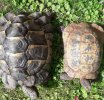Lindsey0106
New Member
Hi, I have two tortoises. The larger one is a couple of inches bigger now compared to when the photo was taken a few years ago. He is now 11 inches long (just the shell) and the small tortoise is around the same size as in the photo, so has stopped growing. The small tortoise (age, at least 30) is a lot older than the big one who is 10. I have been told they are both Mediterranean spur thighed.
Can anyone tell me if this is correct? They are so different in appearance, it's hard for me to believe they are the same species. They also have very different personalities. The larger one is a lot more active and can get quite aggressive. Loves chasing me and biting my toes.. the little one is pretty chilled out.
Can anyone tell me if this is correct? They are so different in appearance, it's hard for me to believe they are the same species. They also have very different personalities. The larger one is a lot more active and can get quite aggressive. Loves chasing me and biting my toes.. the little one is pretty chilled out.

